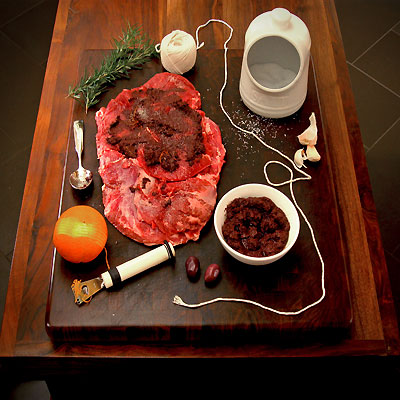Dark ruby red in color, with oak-tinged aromas of black & red fruits, chocolate and spices. Concentrated flavors of blackberry and black cherry are accompanied by the subtle tartness of pomegranate. Unlike many Howell Mountain-sourced wines, this is an elegant wine with medium body, a nice acidity, and a welcomed minerality–much like a great Bordeaux. The wine’s earthiness is perfect with lamb and pairs well with the olive stuffing and rosemary. A wine this elegant is best when paired with flavorful, yet simply prepared foods like Greg’s tapenade-stuffed leg of lamb.
Dancing Bear Ranch is located on Howell Mountain which is located due east of Calistoga in the Vaca Range that defines the eastern side of the Napa Valley. What makes Howell Mountain and other Napa “mountain” AVA’s stand apart from other Napa wines is the fact that it’s above the fog line. In fact the AVA designation begins at this elevation. The fog line is technically an inversion layer– the elevation above which fog typically does not rise during the summer growing season. This means Howell Mountain’s daytime highs are significantly cooler than the valley floor, often 10 to 15 degrees lower than those on the valley floor, and that at up to 2000 feet in elevation, Howell Mountain vineyards enjoy full sun throughout the day. Another factor in Howell Mountain’s distinct flavors is that the soils are entirely volcanic. Rocky, metallic, and nutrient-poor soils keeps the yields small and truly stresses the vines, giving wines made from Howell Mountain grapes their celebrated intensity and elegance.
The ranch is a window into what this area was hundreds of years ago—it’s teeming with wildlife because it’s isolated and there’s not a lot of human activity, so that means we see turkeys, red foxes, mountain lions, bobcats, deer, rabbits, red-tail hawks, falcons and of course see the tracks of the bear which gives the Ranch its name. Harvesting is a challenge; we use aerial imagery to monitor ripeness, vineyard block by vineyard block. It’s a very selective, very slow pick, with many passes. Because the slopes are so steep, our crews work very slowly. It probably takes 50% longer to pick here than on the Valley floor.
Another almost magical part of farming Dancing Bear is the fog. The fog blankets the property; it keeps it cool and it recedes earlier than on the Valley floor. If you ask me what’s unique about what we’re doing here, that’s an easy answer: our level of precision is unique. We use aerial imagery to monitor each of the many vineyard blocks, throughout the growing season, always looking to bring out the full potential for each vine. We also have a computerized weather station sending back reports on ground water, the amount of water in the plants, the evaporation; it’s web-based, so we can access this information when we’re in the field. Bottom line, this means we know, literally vine by vine, if the plants need water or are ripe and more. This is modern mountain farming, where we’re aggressively using technology in the vineyard, all to the end of grape quality.
Winemaker Julianne Laks: Dancing Bear Ranch is a complex and hugely intriguing vineyard to make wine from; to start with, there are multiple exposures at Dancing Bear—different elevations with predominately volcanic, shallow and low fertile soils. The steep rocky slopes offer little water holding capacities, so the vines yield grape bunches with highly concentrated small berries. We harvest Dancing Bear Ranch by hand, by block. As the fruit matures, I walk the vineyards daily to determine the optimal fruit maturity. Picking decisions are based on taste, when the fruit flavors are fully developed with no herbaceous characters, the skin tannin is ripe and the seed tannin is smooth. We also differentiate the vineyard blocks with aerial imagery. These infrared pictures help us to identify areas within a block that show vegetative differences that may impact wine quality. Once we investigate these areas, we will flag them off in the vineyard block and pick these areas separately.
A winemaker’s greatest challenge with mountain wines is to keep tannin extraction balanced with the fruit intensity. So during fermentation it is important to manage the cap to extract the complexity and intensity of the fruit, without extracting harsh, aggressive tannins. We do this with careful cap management and controlled fermentation temperatures.
When I taste the Dancing Bear Ranch wines with people, they are wowed by the power and intensity of the aromas and flavors and they are equally impressed with the balance and drinkability of a mountain wine. Usually people expect a mountain wine to be aggressively tannic unless it is aged 10+ years. To me there are specific characteristic aromatics that are uniquely associated with this ranch. The aroma of the air and earth in this vineyard are translated into the wine. When I taste it, I am transported back to the vineyard with reminiscent scents of a forest after a light rain. It is almost as if the vineyard speaks through the wine: this must be terroir at its finest expression.
Pairs With Food & Wine Pairing- Dancing Bear Ranch Cabernet with Grilled Leg of Lamb
Price $100
Also pairs well with beef, aged cheeses, chocolate, game birds, herbs, venison.
- Category Red Wine
- Varietal Cabernet Sauvignon
- Region Napa Valley CA

